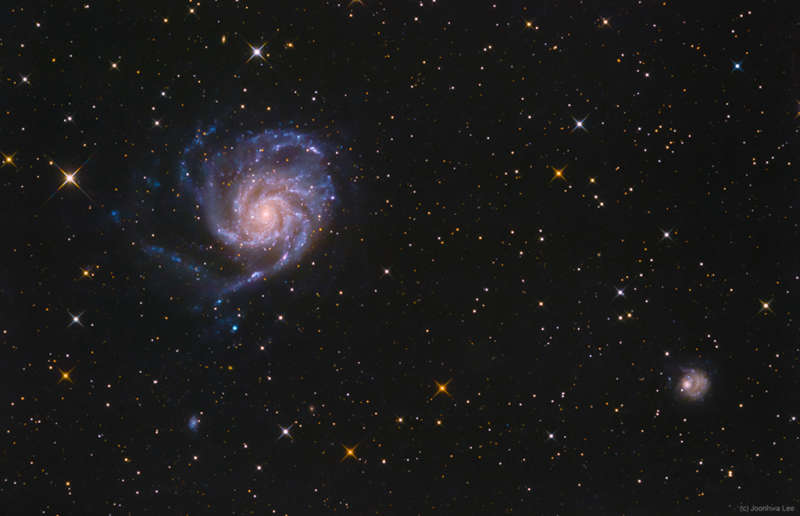
|
Credit & Copyright: Joonhwa Lee
Explanation:
Big, beautiful spiral galaxy M101 is one of the last
entries in Charles
Messier's famous catalog, but definitely not
one
of the least.
About 170,000 light-years across, this galaxy is enormous,
almost twice the size of our own Milky Way galaxy.
M101 was also one of the original
spiral
nebulae observed by Lord Rosse's large
19th century
telescope, the Leviathan of Parsontown.
M101 shares
this modern telescopic field of view with
spiky foreground stars within the Milky Way and
a companion
dwarf galaxy
NGC 5474 (lower right).
The colors of the Milky Way
stars can also be
found in the starlight from the large island universe.
Its core is dominated by light from cool yellowish stars.
Along
its grand design spiral arms are the blue colors of hotter, young stars mixed
with obscuring dust lanes and pinkish star forming regions.
Also known as the
Pinwheel Galaxy,
M101 lies within
the boundaries of the northern constellation Ursa Major,
about 23
million light-years away.
NGC 5474 has likely been distorted by its past gravitational interactions with
the dominant M101.
|
January February March April May June July August September October November December |
| ||||||||||||||||||||||||||||||||||||||||||||||||
NASA Web Site Statements, Warnings, and Disclaimers
NASA Official: Jay Norris. Specific rights apply.
A service of: LHEA at NASA / GSFC
& Michigan Tech. U.
Based on Astronomy Picture
Of the Day
Publications with keywords: M 101 - spiral galaxy
Publications with words: M 101 - spiral galaxy
See also:
- APOD: 2025 September 4 Á NGC 4565: Galaxy on Edge
- APOD: 2025 August 22 Á A Tale of Two Nebulae
- APOD: 2025 August 19 Á Giant Galaxies in Pavo
- APOD: 2025 August 18 Á NGC 1309: A Useful Spiral Galaxy
- APOD: 2025 July 4 Á NGC 6946 and NGC 6939
- APOD: 2025 June 30 Á NGC 4651: The Umbrella Galaxy
- APOD: 2025 June 19 Á NGC 3521: Galaxy in a Bubble
